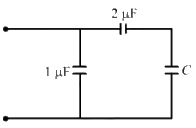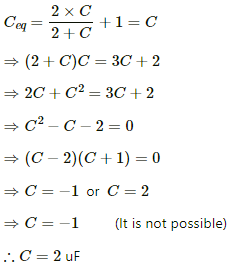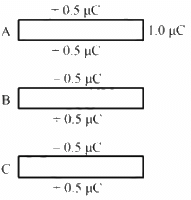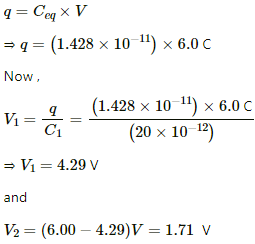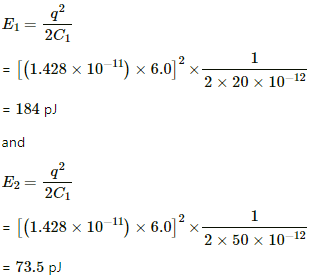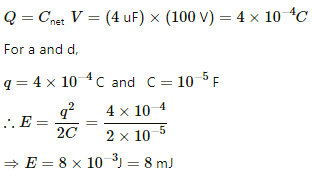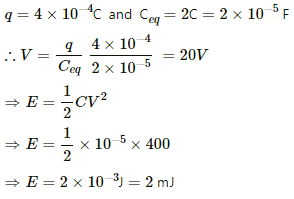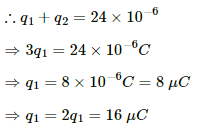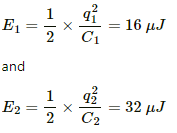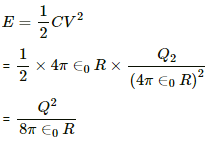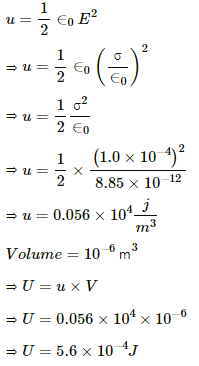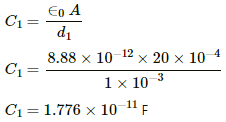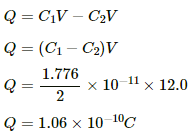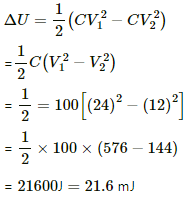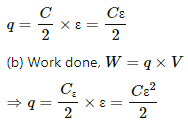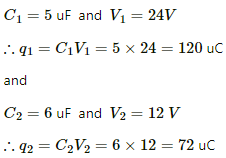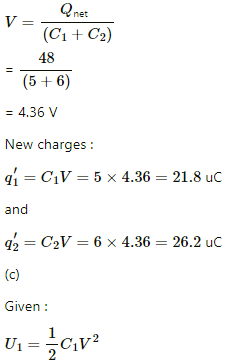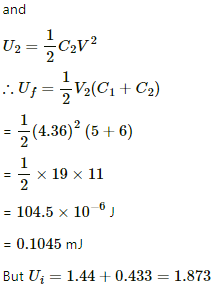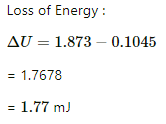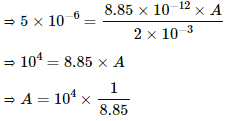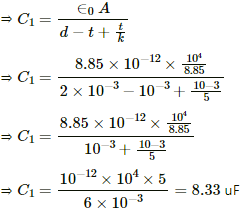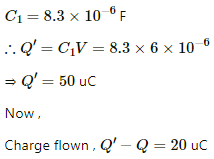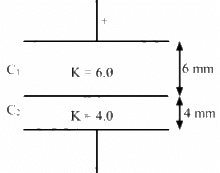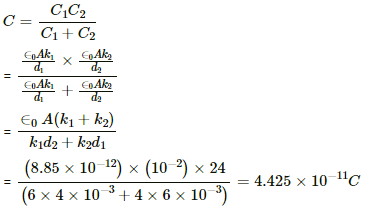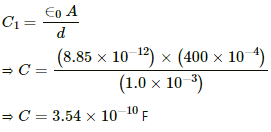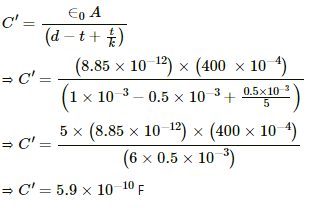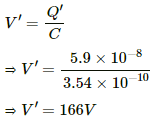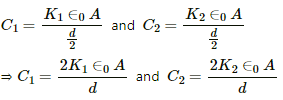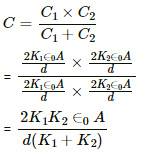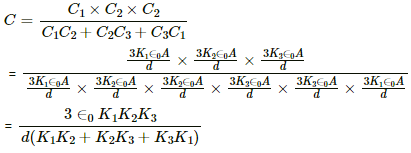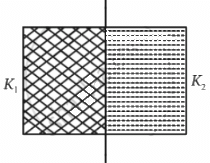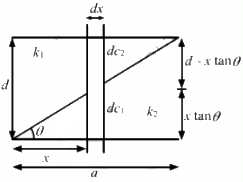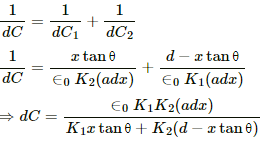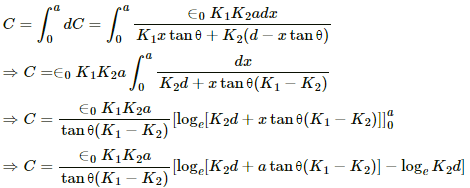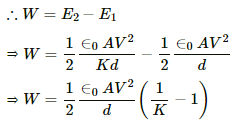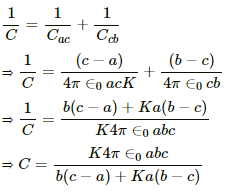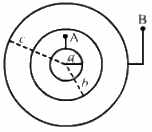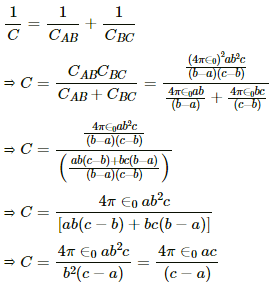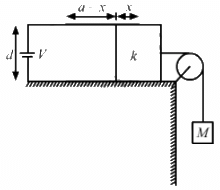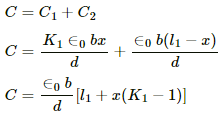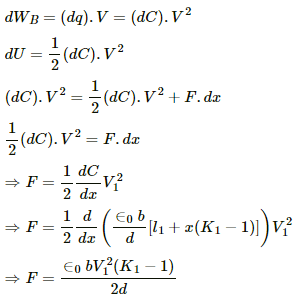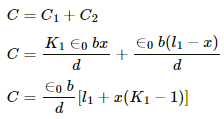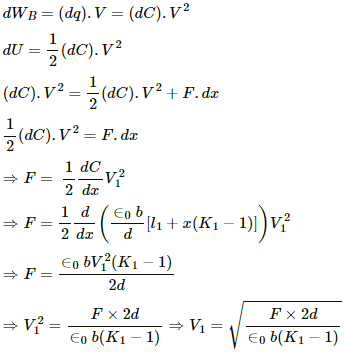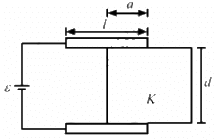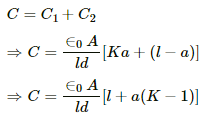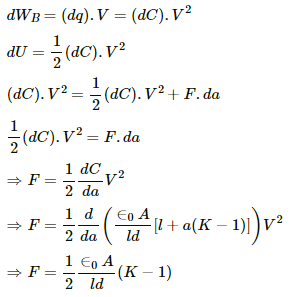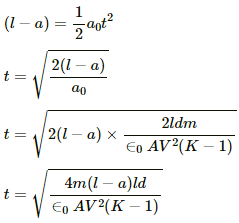HC Verma Questions and Solutions: Chapter 31: Capacitors- 3 | HC Verma Solutions - JEE PDF Download
Q.27. Find the capacitance of the combination shown in figure between A and B.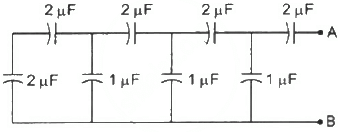
Capacitors 5 and 1 are in series.
Their equivalent capacitance,
Now, this capacitor system is parallel to capacitor 6. Thus, the equivalent capacitance becomes 1 + 1 = 2 μF
The above capacitor system is in series with capacitor 2. Thus, the equivalent capacitance become
The above capacitor system is in parallel with capacitor 7. Thus, the equivalent capacitance becomes 1 + 1 = 2 μF
The above capacitor system is in series with capacitor 3. Thus, the equivalent capacitance becomes
The above capacitor system is in parallel with capacitor 8. Thus, the equivalent capacitance becomes 1 + 1 = 2 μF
The above capacitor system is in series with capacitor 4. Thus, the equivalent capacitance becomes
Hence, the equivalent capacitance between points A and B of the given capacitor system is 1 μF.
Q.28. Find the equivalent capacitance of the infinite ladder shown in figure between the points A and B.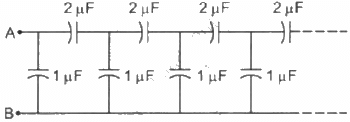
Let the equivalent capacitance of the infinite ladder be C.
Because it is an infinite ladder, the change in the equivalent capacitance will be negligible if we add one more ladder at point AB, as shown in the given figure.
From the given figure, the equivalent capacitance can be calculated as :-
Q.29. A finite ladder is constructed by connecting several sections of 2 µF, 4 µF capacitor combinations as shown in the figure. It is terminated by a capacitor of capacitance C. What value should be chosen for C, such that the equivalent capacitance of the ladder between the points A and B becomes independent of the number of sections in between?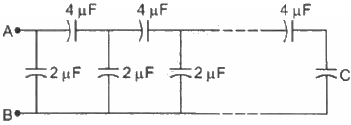
The equivalent capacitance of the ladder between points A and B becomes independent of the number of sections in between when the capacitance between A and B is C.
The capacitors C and 4 µF are in series; their equivalent capacitance is given byThe capacitors C1 and 2 µF are in parallel; their equivalent capacitance is given by C = C1 + 2 µF
⇒ 4C + 8 + 2 C = 4C + C2
⇒ C2 − 2C − 8 = 0
⇒ C = −2, C = 4
Capacitance cannot be negative.
∴ C = 4 µF
The value of C is 4 µF.
Q.30.A charge of  is placed on the positive plate and a charge of
is placed on the positive plate and a charge of  on the negative plate of a parallel-plate capacitor of capacitance
on the negative plate of a parallel-plate capacitor of capacitance  Calculate the potential difference developed between the plates.
Calculate the potential difference developed between the plates.
The charge on the positive plate is q1 and that on the negative plate is q2.
Given :
Now ,
Net charge on the capacitor =
The potential difference developed between the plates is given by q = VC
Q.31. A charge of 20 µC is placed on the positive plate of an isolated parallel-plate capacitor of capacitance 10 µF. Calculate the potential difference developed between the plates.
Given :
Capacitance of the isolated capacitor = 10 µF
Charge on the positive plate = 20 µC
Effective charge on the capacitor =
The potential difference between the plates of the capacitor is given by V = Q/C
∴ Potential difference
Q.32. A charge of 1 µC is given to one plate of a parallel-plate capacitor of capacitance 0⋅1 µF and a charge of 2 µC is given to the other plate. Find the potential difference developed between the plates.
Charges on the plates :
The effective charge on the capacitor is given by
The potential difference is given by
Q.33. Each of the plates shown in figure has surface area  on one side and the separation between the consecutive plates is 4⋅0 mm. The emf of the battery connected is 10 volts. Find the magnitude of the charge supplied by the battery to each of the plates connected to it.
on one side and the separation between the consecutive plates is 4⋅0 mm. The emf of the battery connected is 10 volts. Find the magnitude of the charge supplied by the battery to each of the plates connected to it.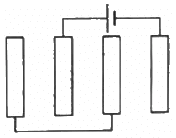
Here, three capacitors are formed and each of them has area A.
Now,
The capacitance of the capacitors is given by
Because the three capacitors are arranged in series, the equivalent capacitance is given by
The total charge on the capacitor is given by
Q = CeqV
The charge on a single plate is given by
Q.34. The capacitance between the adjacent plates shown in figure is 50 nF. A charge of 1⋅0 µC is placed on the middle plate. (a) What will be the charge on the outer surface of the upper plate? (b) Find the potential difference developed between the upper and the middle plates.
(a) When the charge of 1 µC is introduced on plate B, the charge gets equally distributed on its surface. All sides of the plate gets 0.5 µC of charge. Due to induction, 0.5 µC charge is induced on the upper surface of plate A.
(b) Given:-
Capacitance, C = 50 nF =
Effective charge on the capacitor,
∴ Potential difference between plates B and A,
Q.35. The capacitance between the adjacent plates shown in the figure is 50 nF. A charge of 1.0µC is placed on the middle plate. If 1.0 µC is placed on the upper plate instead of the middle, what will be the potential difference between (a) the upper and the middle plates and (b) the middle and the lower plates?
When 1µC charge is given to the upper plate, the charge gets distributed. The two sides of the upper plate havecharge. One side of the middle plate facing the upper plate has
charge and the other side has
Change . Similarly, one side of the lower plate facing the middle plate has
charge and the other side has
charge.
(a) Effective charge on the capacitor formed by the upper and middle plates = 0.5 µC
Capacitance = 50 nF = 0.05 µF
∴ Potential difference between the plates,
(b) Effective charge on the capacitor formed by the middle and lower plates = 0.5 µC
Capacitance = 0.50 µF
∴ Potential difference between the plates,
Q.36. Two capacitors of capacitance 20⋅0 pF and 50⋅0 pF are connected in series with a 6⋅00 V battery. Find (a) the potential difference across each capacitor and (b) the energy stored in each capacitor.
Given :
When the capacitors are connected in series, their equivalent capacitance is given by
∴ Equivalent capacitance,
(a) The charge on both capacitors is equal as they are connected in series. It is given by
(b) The energies in the capacitors are given by
Q.37. Two capacitors of capacitances 4⋅0 µF and 6⋅0 µF are connected in series with a battery of 20 V. Find the energy supplied by the battery.
Given :
Now,
The equivalent capacitance is given by
The energy supplied by the battery is given by
Q.38. Each capacitor in figure has a capacitance of 10 µF. The emf of the battery is 100 V. Find the energy stored in each of the four capacitors.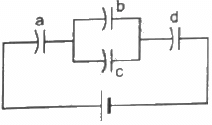
Capacitors b and c are in parallel; their equivalent capacitance is 20 µF.
Thus, the net capacitance of the circuit is given by
The total charge of the battery is given by
For b and c,
Q.39. A capacitor with stored energy 4⋅0 J is connected with an identical capacitor with no electric field in between. Find the total energy stored in the two capacitors.
Given :
Energy stored in the charged capacitor = 4.0 J
When the capacitors are connected, the charge flows from the charged capacitor to the uncharged capacitor. Because the capacitors are identical, the charge flows till the charge in both the capacitors becomes equal.
The energy of a capacitor is given by E = q2/2C
As the charge in both the capacitors is the same, their capacitance is also the same. So, the energy is equally divided between them.
Thus, the energy stored in each of the capacitors is 2.0 J.
Q.40. A capacitor of capacitance 2⋅0 µF is charged to a potential difference of 12 V. It is then connected to an uncharged capacitor of capacitance 4⋅0 µF as shown in figure . Find (a) the charge on each of the two capacitors after the connection, (b) the electrostatic energy stored in each of the two capacitors and (c) the heat produced during the charge transfer from one capacitor to the other.
Charge on the 2 µF capacitor when it is not connected to the 4 µF capacitor is given by
(a) On connecting the capacitors, the charge flows from the 2 µF capacitor to the 4 µF capacitor.
Now, let the charges on the 2 µF and 4 µF capacitors be q1 and q2, respectively.
As they are connected in parallel, the potential difference across them is the same.
The total charge on the capacitors will be the same as the initial charge stored on the 2 µF capacitor.
(b) Energies stored in the capacitors are given by
(c) Initial energy stored in the 2 µF capacitor is given by
Total energy of the capacitors after they are connected in parallel is given by
Ef = E1 + E2
⇒ Ef = 16 + 32 = 48 μJ
Heat produced during the charge transfer is given by
Q.41. A point charge Q is placed at the origin. Find the electrostatic energy stored outside the sphere of radius R centred at the origin.
Given :
Charge on the sphere = Q
Radius of the sphere = R
Capacitance of the sphere,
Thus, the energy of the sphere is given by
Q.42. A metal sphere of radius R is charged to a potential V. (a) Find the electrostatic energy stored in the electric field within a concentric sphere of radius 2 R. (b) Show that the electrostatic field energy stored outside the sphere of radius 2 R equals that stored within it.
Potential of the inner metallic sphere is given by V =
Capacitance of the capacitor formed by two concentric spheres of radii R and 2R is given by
Potential of the outer sphere is given by
Electrostatic energy stored outside the sphere is given by
Q.43. A large conducting plane has a surface charge density  Find the electrostatic energy stored in a cubical volume of edge 1⋅0 cm in front of the plane.
Find the electrostatic energy stored in a cubical volume of edge 1⋅0 cm in front of the plane.
Given,
Surface charge density of the plane,
Volume of the cube,
Electric field near the charged conducting plane is given as ,.... (i)
Energy density of electric filed,
Q.44. A parallel-plate capacitor having plate area 20 cm2 and separation between the plates 1⋅00 mm is connected to a battery of 12⋅0 V. The plates are pulled apart to increase the separation to 2⋅0 mm. (a) Calculate the charge flown through the circuit during the process. (b) How much energy is absorbed by the battery during the process? (c) Calculate the stored energy in the electric field before and after the process. (d) Using the expression for the force between the plates, find the work done by the person pulling the plates apart. (e) Show and justify that no heat is produced during this transfer of charge as the separation is increased.
Given :
Initial Capacitance of the capacitor ;
Final capacitance of the capacitor :
(a) Charge flown through the circuit :
(b) Energy absorbed by the battery :
(c) Energy stored before the process,
Energy stored after the process,
(d) Work done, W = Force × Distance
W = Change in the energy
⇒ W = 6.35 × 10−10 J
Q.45. A capacitor having a capacitance of 100 µF is charged to a potential difference of 24 V. The charging battery is disconnected and the capacitor is connected to another battery of emf 12 V with the positive plate of the capacitor joined with the positive terminal of the battery. (a) Find the charges on the capacitor before and after the reconnection. (b) Find the charge flown through the 12 V battery. (c) Is work done by the battery or is it done on the battery? Find its magnitude. (d) Find the decrease in electrostatic field energy. (e) Find the heat developed during the flow of charge after reconnection.
(a) Before connecting to the battery of 12 volts,
After connecting to the battery of 12 volts,
(b) Charge flown through the 12 V battery is 1200μC.
(c) We know,
= 14400 J
= 14.4 mJ
It is the work done on the battery.
(d) Initial electrostatic field energy :
Final electrostatic field energy:
Decrease in the electrostatic field energy :
(e) After reconnection,
Heat developed during the flow of charge after reconnection is given by
This amount of energy is developed as heat when the charge flows through the capacitor.
Q.46. Consider the situation shown in the figure. The switch S is open for a long time and then closed. (a) Find the charge flown through the battery when the switch S is closed. (b) Find the work done by the battery.(c) Find the change in energy stored in the capacitors.(d) Find the heat developed in the system.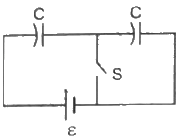
Since the switch is opened for a long time, the capacitor is in series.
When the switch is closed, the charge flown from the battery is given by
(c) The change in the energy stored in the capacitors is given by
(d) The heat developed in the system is given by
H = ΔE
Q.47. A capacitor of capacitance 5⋅00 µF is charged to 24⋅0 V and another capacitor of capacitance 6⋅0 µF is charged to 12⋅0 V. (a) Find the energy stored in each capacitor. (b) The positive plate of the first capacitor is now connected to the negative plate of the second and vice versa. Find the new charges on the capacitors. (c) Find the loss of electrostatic energy during the process. (d) Where does this energy go?
Given :
(a) Energy stored in the first capacitor :
Energy stored in the second capacitor :
(b) The capacitors are connected to each other in such a way that the positive plate of the first capacitor is connected to the negative plate of the second capacitor and vice versa.
∴ Net change in the system,
Now, let V be the common potential of the two capacitors.
From the conservation of charge before and after connecting, we get
(d) The energy is dissipated as heat.
Q.48. A 5⋅0 µF capacitor is charged to 12 V. The positive plate of this capacitor is now connected to the negative terminal of a 12 V battery and vice versa. Calculate the heat developed in the connecting wires.
As a capacitor of capacitance C is connected to the battery of voltage V, one of its plates gets charged to Q = CV and the other gets charged to −Q coulomb. When the polarity is reversed, charge −Q appears on the first plate and charge +Q appears on the second plate. So to maintain these charges, charge 2Q passes through the battery from the negative terminal to the positive terminal.
The work done by the battery is given by
In the given process, the capacitor's energy remains the same in both cases. The work done by the battery appears as heat in the connecting wires.
Now,
Heat produced :
Q.49. The two square faces of a rectangular dielectric slab (dielectric constant 4⋅0) of dimensions 20 cm × 20 cm × 1⋅0 mm are metal-coated. Find the capacitance between the coated surfaces.
The area of the plates of the capacitor is given by
The separation between the parallel plates is given by
Here, the thickness of the dielectric is the same as the separation between the parallel plates.
Thus, the capacitance is given by
Q.50. If the above capacitor is connected across a 6⋅0 V battery, find (a) the charge supplied by the battery, (b) the induced charge on the dielectric and (c) the net charge appearing on one of the coated surfaces.
Given :
Capacitance of the capacitor, C = 1.42 nF
Dielectric constant, k = 4
Voltage of the battery connected, V = 6 V
(a) The charge supplied by the battery is given by
(b) The charge induced on the dielectric is given by
(c) The charge appearing on one of the coated plates is given by
Q.51. The separation between the plates of a parallel-plate capacitor is 0⋅500 cm and its plate area is 100 cm2. A 0⋅400 cm thick metal plate is inserted into the gap with its faces parallel to the plates. Show that the capacitance of the assembly is independent of the position of the metal plate within the gap and find its value.
Given:
Area of the plate = 100 cm2
Separation between the plates =
Thickness of the metal,
Here,
k = Dielectric constant of the metal
d = Separation between the plates
t = Thickness of the metal
For the metal, k = ∞
Here, the capacitance is independent of the position of the metal. At any position, the net separation is (d − t).
Q.52. A capacitor stores 50 µC charge when connected across a battery. When the gap between the plates is filled with a dielectric, a charge of 100 µC flows through the battery. Find the dielectric constant of the material inserted.
Given:
Initial charge on the capacitor = 50 µC
Now, let the dielectric constant of the material inserted be k.
As 100 µC of extra charge flows through the battery, the net charge on the capacitor becomes
50 + 100 = 150 µC
Now ,
On dividing (i) by (ii), we get
Thus, the dielectric constant of the given material is 3.
Q.53. A parallel-plate capacitor of capacitance 5 µF is connected to a battery of emf 6 V. The separation between the plates is 2 mm. (a) Find the charge on the positive plate. (b) Find the electric field between the plates. (c) A dielectric slab of thickness 1 mm and dielectric constant 5 is inserted into the gap to occupy the lower half of it. Find the capacitance of the new combination. (d) How much charge has flown through the battery after the slab is inserted?
For the given capacitor,
(a) The charge on the positive plate is calculated using q = CV.
Thus,
(b) The electric field between the plates of the capacitor is given by
(c) Separation between the plates of the capacitor, d = 2 x 10-3m
Dielectric constant of the dielectric inserted, k = 5
Thickness of the dielectric inserted, t = 1 x 10-3m
Now,
Area of the plates of the capacitor
When the dielectric placed in it, the capacitance becomes
(d) The charge stored in the capacitor initially is given by
Also ,
V = 6 V
Now ,
The charge on the capacitor after inserting the dielectric slab is given by
Q.54. A parallel-plate capacitor has plate area 100 cm2 and plate separation 1⋅0 cm. A glass plate (dielectric constant 6⋅0) of thickness 6⋅0 mm and an ebonite plate (dielectric constant 4⋅0) are inserted one over the other to fill the space between the plates of the capacitor. Find the new capacitance.
The given system of the capacitor will behave as two capacitors connected in series.
Let the capacitances be C1 and C2.
Now,
Thus, the net capacitance is given by
= 44.25 pF
Q.55. A parallel-plate capacitor having plate area 400 cm2 and separation between the plates 1⋅0 mm is connected to a power supply of 100 V. A dielectric slab of thickness 0⋅5 mm and dielectric constant 5⋅0 is inserted into the gap. (a) Find the increase in electrostatic energy. (b) If the power supply is now disconnected and the dielectric slab is taken out, find the further increase in energy. (c) Why does the energy increase in inserting the slab as well as in taking it out?
The capacitance of the capacitor without the dielectric slab is given by
When the dielectric slab is inserted, the capacitance becomes
(a) Increased electrostatic energy :
(b) Charge on the capacitor containing dielectric is,
Potential difference across the capacitor after removing battery and then dielectric is,
Increased electrostatic energy,
(c) When the battery is connected, energy is increased after insertion of the dielectric slab because of the increase in the capacitance of the capacitor. Now, capacitor will abstract more change from the battery.
When the battery is disconnected, and dielectric slab is taken out then energy stored in the will increase because of increase of potential difference across the capacitor.
Q.56. Find the capacitances of the capacitors shown in figure . The plate area is A and the separation between the plates is d. Different dielectric slabs in a particular part of the figure are of the same thickness and the entire gap between the plates is filled with the dielectric slabs.
The two parts of the capacitor are in series with capacitances C1 and C2.
Here,
Because they are in series, the net capacitance is calculated as :
(b) Here, the capacitor has three parts. These can be taken in series.
Now,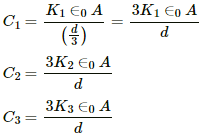
Thus, the net capacitance is calculated as :
(c)
Here,
These two parts are in parallel.
Q.57. A capacitor is formed by two square metal-plates of edge a, separated by a distance d. Dielectrics of dielectric constant K1 and K2 are filled in the gap as shown in figure . Find the capacitance.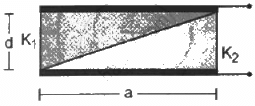
Let us consider an elemental capacitor of width dx at a distance x from the left end of the capacitor. It has two capacitive elements of dielectric constants K1 and K2 with plate separations (x tan θ) and (d − x tan θ) in series, respectively. The areas of the plates of the capacitors are adx.
The capacitances of the capacitive elements of the elemental capacitor are :
The net capacitance of the elemental capacitor is given by
Thus, integrating the above expression to calculate the net capacitance
As we know thatsubstituting in the expression for capacitance C.
Now,
Q.58. Figure shows two identical parallel plate capacitors connected to a battery through a switch S. Initially, the switch is closed so that the capacitors are completely charged. The switch is now opened and the free space between the plates of the capacitors is filled with a dielectric of dielectric constant 3. Find the ratio of the initial total energy stored in the capacitors to the final total energy stored.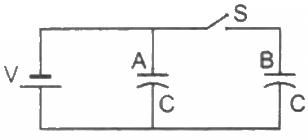
When the switch is closed, both capacitors are in parallel.
⇒ The total energy of the capacitor when the switch is closed is given by
When the switch is opened and the dielectric is induced, the capacitance of the capacitor A becomes
The energy stored in the capacitor A is given by
The energy in the capacitor B is given by
∴ Total final Energy
Now,
Ratio of the energies,
Q.59. A parallel-plate capacitor of plate area A and plate separation d is charged to a potential difference V and then the battery is disconnected. A slab of dielectric constant K is then inserted between the plates of the capacitor so as to fill the space between the plates. Find the work done on the system in the process of inserting the slab.
Initial capacitance,
The energy of the capacitor before the insertion of the dielectric is given by
After inserting the dielectric slab, the capacitance becomes
and the final voltage becomes
Thus, the final energy stored in the capacitor is given by
Now,
Work done = Change in energy
Q.60. A capacitor having a capacitance of 100 µF is charged to a potential difference of 50 V. (a) What is the magnitude of the charge on each plate? (b) The charging battery is disconnected and a dielectric of dielectric constant 2⋅5 is inserted. Calculate the new potential difference between the plates. (c) What charge would have produced this potential difference in absence of the dielectric slab. (d) Find the charge induced at a surface of the dielectric slab.
(a) The magnitude of the charge can be calculated as:
Charge = Capacitance × Potential difference
(b) When a dielectric is introduced, the potential difference decreases.
We know,
(c) Now, the charge on the capacitance can be calculated as:
Charge = Capacitance × Potential difference
(d) The charge induced on the dielectric can be calculated as :
Q.61. A sphercial capacitor is made of two conducting spherical shells of radii a and b. The space between the shells is filled with a dielectric of dielectric constant K up to a radius c as shown in figure . Calculate the capacitance.
We have two capacitors: one made by the shells a and c and the other made by the shells b and c.
The capacitance of the capacitor Cac is given by
The capacitance of the capacitor Ccb is given by
The two capacitors are in series; thus, the equivalent capacitance is given by
Q.62. Consider an assembly of three conducting concentric spherical shell of radii a, b and c as shown in figure Find the capacitance of the assembly between the points Aand B.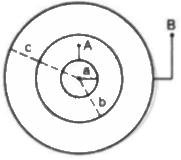
The spherical shells form two spherical capacitors: one made by A and B and the other made by B and C.
The capacitance of the spherical capacitor made by the shells of radii r1 and r2 is given by
The capacitance of the capacitor made by A and B is given by
The capacitance of the capacitor made by B and C is given by
As the capacitors are in series, the net capacitance is given by
Q.63. Suppose the space between the two inner shells is filled with a dielectric of dielectric constant K. Find the capacitance of the system between A and B.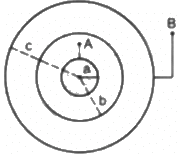
Since the space between the two inner shells is filled with a dielectric, capacitance CAB becomes
and capacitance CBC becomes
Now, as the capacitors are in series, the equivalent capacitance is given by
Q.64. An air-filled parallel-plate capacitor is to be constructed which can store 12 µC of charge when operated at 1200 V. What can be the minimum plate area of the capacitor? The dielectric strength of air is 3 x 106 Vm-1.
Charge that the capacitor can hold = 12 μC
Operating voltage = 1200 V
Breakdown strength, b =
The separation between the plates of the capacitor is given by
The capacitance of the capacitor is given by
The capacitance can be expressed in terms of the area of the plates (A) and the separation of the plates (d) as :
Thus, the area of the plates is given by
Q.65. A parallel-plate capacitor with the plate area 100 cm2 and the separation between the plates 1⋅0 cm is connected across a battery of emf 24 volts. Find the force of attraction between the plates.
Area of the plates of the capacitor, A = 100 cm2 = 10-2m2
Separation between the plates, d = 1 cm = 10-2 m
Emf of battery, V = 24 V
Therefore,
Capacitance,
Energy stored in the capacitor,
Force of attraction between the plates,
Q.66. Consider the situation shown in figure (31-E29). The width of each plate is b. The capacitor plates are rigidly clamped in the laboratory and connected to a battery of emf ε. All surfaces are frictionless. Calculate the value of M for which the dielectric slab will stay in equilibrium.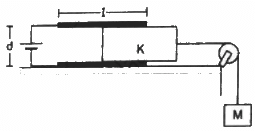
Let the potential of the battery connected to the capacitor be V.
Let the length of the part of the slab inside the capacitor be x.
The capacitor can be considered to be two capacitors in parallel.
The capacitances of the two capacitors in parallel are :-
C1 is the part of the capacitor having the dielectric inserted in it and C2 is the capacitance of the part of the capacitor without dielectric.
As, C1 and C2 are in parallel.
Therefore, the net capacitance is given by
The dielectric slab is attracted by the electric field of the capacitor and applies a force in left direction.
Let us consider electric force of magnitude F pulls the slab in left direction.
Let there be an infinitesimal displacement dx in left direction by the force F.
The work done by the force = F.dx
Let the potential of the battery connected to the left capacitor be V1 and that of the battery connected with the right capacitor be V2.
With the displacement of slab, the capacitance will increase, therefore the energy of the capacitor will also increase. In order to maintain constant voltage, the battery will supply extra charges, therefore the battery will do work.
Work done by the battery = change in energy of capacitor + work done by the force F on the capacitor
Let the charge dq is supplied by the battery, and the change in the capacitor be dC
To keep the dielectric slab in equilibrium, the electrostatic force on it must be counteracted by the weight of the block attached.
Therefore,
Q.67. Figure shows two parallel plate capacitors with fixed plates and connected to two batteries. The separation between the plates is the same for the two capacitors. The plates are rectangular in shape with width b and lengths l1 and l2. The left half of the dielectric slab has a dielectric constant K1 and the right half K2. Neglecting any friction, find the ration of the emf of the left battery to that of the right battery for which the dielectric slab may remain in equilibrium.
Let the potential of the battery connected to the left capacitor be V1 and that of the battery connected to the right capacitor be V2.
Considering the left capacitor,
Let the length of the part of the slab inside the capacitor be x.
The left capacitor can be considered to be two capacitors in parallel.
The capacitances of the two capacitors in parallel are :-
C1 is the part of the capacitor having the dielectric inserted in it and C2 is the capacitance of the part of the capacitor without dielectric.
As, C1 and C2 are in parallel.
Therefore, the net capacitance is given by
Therefore, the potential energy stored in the left capacitor will be
The dielectric slab is attracted by the electric field of the capacitor and applies a force in left direction.
Let us consider electric force of magnitude F pulls the slab in left direction.
Let there be an infinitesimal displacement dx in left direction by the force F.
The work done by the force = F.dx
Let us consider a small displacement dx of the slab in the inward direction. The capacitance will increase, therefore the energy of the capacitor will also increase. In order to maintain constant voltage, the battery will supply extra charges, therefore the battery will do work.
Work done by the battery = change in energy of capacitor + work done by the force F on the capacitor
Let the charge dq is supplied by the battery, and the change in the capacitor be dC
Similarly, for the right side the voltage of the battery is given by
Thus , the ratio of the voltages is given by
Thus, the ratio of the emfs of the left battery to the right battery is
Q.68. Consider the situation shown in figure. The plates of the capacitor have plate area A and are clamped in the laboratory. The dielectric slab is released from rest with a length a inside the capacitor. Neglecting any effect of friction or gravity, show that the slab will execute periodic motion and find its time period.
Given that the area of the plates of the capacitors is A.
As ''a'' length of the dielecric slab is inside the capacitor.
Therefore, the area of the plate covered with dielectric is = (A/l)a
The capacitance of the portion with dielectric is given by
The capacitance of the portion without dielectric is given by
The two parts can be considered to be in parallel.
Therefore, the net capacitance is given by
Let us consider a small displacement da of the slab in the inward direction. The capacitance will increase, therefore the energy of the capacitor will also increase. In order to maintain constant voltage, the battery will supply extra charges, therefore the battery will do work.
Work done by the battery = change in energy of capacitor + work done by the force F on the capacitor
Let the charge dq is supplied by the battery, and the change in the capacitor be dC
The acceleration of the dielectric is given by
As, the force is in inward direction, it will tend to make the dielectric to completely fill the space inside the capacitors. As, the dielectric completely fills the space inside the capacitor at this instant its velocity is not zero. The dielectric slab tends to move outside the capacitor. As the slab tends to move out, the direction of the force due to the capacitor will reverse its direction. Thus, the dielectric slab will have a periodic motion.
The time taken to move distance (l - a) can be calculated as :-
For the complete cycle the time period will be four times the time taken for covering distance (l - a).
It is given by :-.
|
134 docs
|







